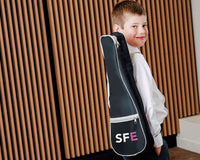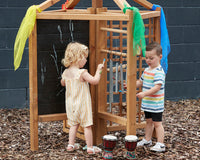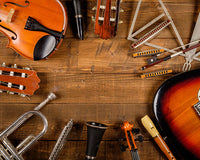There are many things to consider when buying a trombone as their playing characteristics vary more than almost any other instrument - from an agile small bore jazz instrument right through to a powerful large bore dual rotor bass trombone. Consequently the range and diversity of different specifications is mind boggling. I've therefore highlighted some of the key areas to consider when choosing your instrument.
Check out our full range of trombones: HERE
Bore
- The bore size of trombones vary dramatically - from a .485" bore on a Bb jazz instrument to .562" on a bass trombone (this might not sound like a big difference but trust me it is!).
- Typically however, most tenor trombone players opt for either a medium large bore (.525") for ease of control and tonal flexibility or a symphonic large bore (.547") for greater projection and depth.
Bell Shape, Diameter, Material and Thickness
- The shape of the bell flare (rate of taper), and type and thickness of bell material greatly affect the sound of a trombone. As the bore size changes, so does the bell design.
- The shape of the tapered surface, or rate of flare determines the characteristic sound of the instrument. Slow tapers yield bright tones, while fast tapers produce dark, warm sounds.
- Smaller bore trombones, having bells with slower rates of taper produce a brighter jazz sound. Larger bore trombones having bells with faster rates of taper, yield darker symphonic tone qualities.
- Bell diameters also vary between 6 1/2" and 10 1/2" with some manufactures giving you the option of a larger bell diameter for greater dynamics. A wider bell produces a fatter/rounder sound as opposed to the more direct projection achieved when using a smaller one.
- The type of brass used in the bell also impacts on the sound produced. Gold brass, softer and redder than the standard yellow brass (due to a higher copper content - 85%), is claimed to offer a warm tone; yellow brass a clearer tone. Lightweight (thinwall) bells allow for a more immediate response.
Key/Pitch
- Almost all trombones are pitched principally in Bb (with the exception of alto trombones in Eb), however the addition of extra tubing sections (engaged using rotary valves) transpose the instrument into lower keys to extend the trombones range lower, help tuning, and to create alternative slide positions to aid in playing fast passages.
- Tenor trombones will often have an "F attachment" - so if you engage the rotor in first position (slide fully closed) it is as if you are playing an F in 6th position. Bass trombones sometimes have two rotors which enable a number of permutations dependant on the valve configuration.
Rotary Valves
- The type of rotor used on Bb/F and bass trombones also varies. Traditionally normal rotor valves (similar to those found on french horns) have been used but are considered by some to constrict the airflow thus adding to the resistance of the instrument when played.
- In addition, there is often a small 'pop' when the rotor is engaged. Therefore, a number of new rotors have been developed over recent years and incorporated into trombones to create a more free blowing and 'pop free' rotor.
- These include the CL2000 (Conn), Hagmann (Besson and Bach) and Thayer (Bach and Edwards). Whilst designs vary, the general theme is a bigger rotor with larger diameter internal airways and a straighter airflow, thus reducing the constriction of air which can lead to blowing resistance.
- All these rotors have their own pros and cons, but share the same characteristic of generally being more expensive than the standard option!
- Perhaps because of this, or due to the fact that some players prefer or are used to the resistance of a normal rotor means that the standard rotor is still the biggest seller, however all the rotors mentioned have their loyal fans.
Open or Closed Wrap?
- Traditionally the F section (or both sections of a bass trombone) have been wrapped within the body of the trombone - offering compactness, protection and a secure blowing feel.
- Many manufacturers however also offer an 'open wrap' option. Open wrapping the rotor section(s) places fewer and larger bends in the tubing, resulting in a more free-blowing instrument. Usually an open wrap configuration is combined with a free blowing rotor.
Bass Trombone Configurations
- Bass trombones come in a variety of configurations which determine the range of keys the instrument can be played in - and consequently the notes which can be played and slide positional computations.
- Single rotor bass trombones have one 'F rotor' like a Bb/F tenor trombone, but with a larger bore, slower bell taper and wider bell diameter for a more powerful broader tone.
- Double (non-independent) rotor systems have two rotors, but to engage the second the first must also be engaged. Thus the key variations are Bb (open), F (first valve engaged), and Eb (first and second valves engaged).
- This option is rarely used/sold these days but worth being aware of so you don't buy one in error! Double in-line independent rotor system bass trombones allow both rotors to be engaged independently of each other.
- Thus the key variations are Bb (open), F (first valve engaged), Eb (first and second valves engaged) and G (second valve engaged).
- Most independent system instruments come with an additional slide for the second rotor section allowing the key combinations of Bb/F/ D/Gb to allow for greater flexibility and key permutations dependant on the players needs.
Leadpipes
- The venturi (construction) and rate of taper in the mouthpipe affect the trombone's characteristic sound.
- Different leadpipes can vary the blowing resistance, flexibility of sound and focus of tone.
- Some instruments come with interchangeable leadpipes so players can choose the configuration that best suits their individual needs.
Slides
- Some musicians prefer the feel and quick response of a lightweight slide. The weight is reduced by using nickel silver tubing for the outer slide. In addition to saving weight, nickel silver also resists corrosion and helps produce a light clear tone.
- So as you can see, there are a multitiude of choices when looking to replace or upgrade your trombone and what suits one persons style of play is not always right for another.
- It is worth noting here though that choosing a highly 'bespoke' instrument can have its issues and I would always advocate choosing an off the shelf model that has been tried and tested by both manufacturers and players alike.
If you have any queries, please don't hesitate to contact our team: sales@normans.co.uk




















